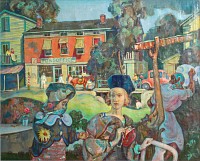BIOGRAPHY

Fred Greene Carpenter, American (1882-1965)
Carpenter was born in Nashville, Tennessee in 1882, moved to St. Louis and entered Washington University’s School of Fine Arts in 1900. He spent the summer of 1902 in Paris, then worked as a guide to the St. Louis World’s Fair’s art exhibition, before becoming a faculty member at his alma mater. He would remain there until 1952.
”¨Soon Carpenter returned to Paris to study at the Académie Julian (under Jean-Paul Laurens and others) and at the Colarossi Academy, where his teacher Richard E. Miller became an important influence. In 1910, Carpenter’s painting The Sisters won an Honorable Mention at the Paris Salon. Back in St. Louis, he married an art student named Mildred Bailey (b. 1894) in 1914. At the Panama-Pacific International Exposition in 1915, Carpenter submitted The Gay Set, which depicted the dressing room in a theater — it won a silver medal. Both Mr. and Mrs. Carpenter continued to exhibit their works and win prizes and medals. Fred Carpenter exhibited mostly at the Pennsylvania Academy (1908-31), where one of his works may be found today: Rose Color, Scarlet and Black, a theatrical scene dated 1912.”¨”¨Carpenter was commissioned to paint lunettes in the Missouri State Capitol, in 1921, then he took a year to execute the actual canvases in their summer home in Wisconsin: The Battle of Sacramento and The Entry into Havana. Another opportunity came later in 1940 when Carpenter was asked to paint a mural in the Paris, Missouri Post Office. The subject was The Clemens Family Arrives in Monroe County. After Carpenter’s death, one student wrote, “He was known for being a marvelous colorist. Today I still see his influence on his student’s students. His color had a jewel-like quality. He thought every inch of a painting should be fascinating . . . and a painting should be as interesting close up as from a distance.” (Quoted from the St. Louis Post-Dispatch, 16 April 1967). Mildred Carpenter remarked that her husband’s colorful, decorative images of beautiful women and children and costume parties led viewers to believe “that he was worldly, or sensual; whereas, he was, in fact, a philosophical, simple, romantic, shy person.” (Carpenter Papers, Washington University Archives). She called her husband an impressionist-realist-expressionist. His typical canvas is richly decorative and animated with a cheerful palette of highly saturated colors. The frequently curvilinear forms exhibit well defined contours. There is often an exotic subject, such as Woman of Babylon, or a romantic locale. While The Gossips, illustrated in the 1927 PAFA catalogue, appears to be set in Northern Africa, there are several works from trips to Spain: A Street in Granada; An Andalusian Gypsy. In both theme and painting technique such works recall those of Carpenter’s contemporary Francis Luis Mora. The artist died in 1965.”¨
